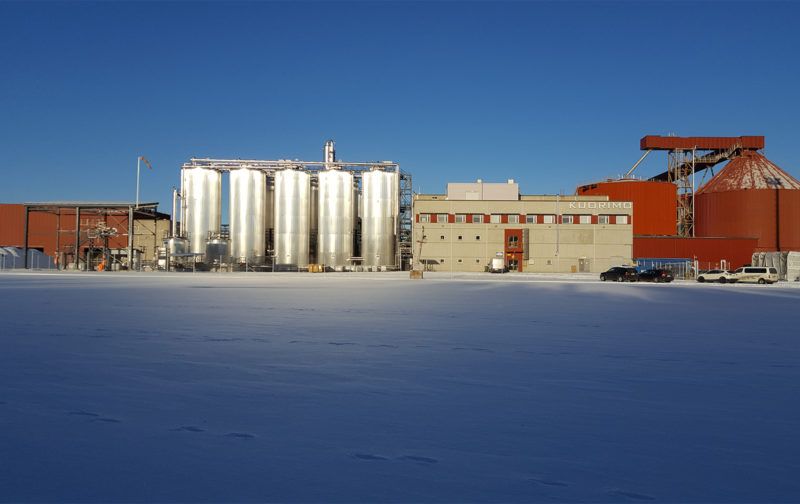St1 aims to increase its production of wood-based bioethanol 15-fold – by-products of forest industry replace fossil raw materials and increase carbon sink in agricultural lands

Energy company St1 demonstrates the profitability of producing sawdust-based ethanol in its Kajaani plant in north-eastern Finland. Environmental impact assessments have been completed for three new plants to be built in the Nordic countries.
Each of the three plants would be five times the size of the Kajaani demonstration plant. Their raw material would consist of sawdust and other wood residues.
The plants are planned in Pietarsaari on the west coast of Finland, in Kajaani and in Norway. The value of the investment for each plant would be EUR 200 million.
At full capacity, the Kajaani demonstration plant uses 80,000 tons of sawdust annually. Out of this the plant produces ten million litres of ethanol, 10,000 tonnes of vinasse, used as nitrogenous fertilizer, 30,000 tonnes of lignin, 150 tonnes of turpentine and 500 tonnes of furfural, used in the chemical industry.
All products are biobased and replace fossil-based production. Vinasse, for example, replaces fossil-based nitrogen and increases the amount of organic material in agricultural soil – in other words, it increases the soil carbon sink.
Profitability is still uncertain
The demonstration plant was taken into use in 2017. The big question continues to be whether the production of sawdust-based ethanol is profitable. The items causing the highest costs in the production are sawdust, enzymes and energy.
’Our technology is not quite perfected yet. The main problem is perhaps that it is too expensive,’ says Patrick Pitkänen, Director of Biorefining Business Development at St1.
In Kajaani, many factors contribute to a greater profitability. ”For example, our main raw material, sawdust, contains 50 percent water. Transporting it over long distances is not very economical, and that’s why our plant is situated right next to the Pölkky sawmill,’ says Pitkänen.
The demonstration plant employs 15 persons and operates round the clock in three shifts.
”We’re not planning to fell forest”
St1 also makes ethanol from waste material from food industries at three locations in Finland and one in Sweden. Biowaste from households and grocery shops is refined to ethanol in Finland as well.
In September, the company made an investment decision concerning the construction of a plant to produce renewable diesel fuel in Gothenburg, Sweden, in co-operation with the forest industry company SCA. One of the raw materials used by the plant is tall oil, a by-product of pulp manufacturing from SCA.
St1 wants to invest in refining wood-based biofuels because there is a strong forest industry in the Nordic countries with considerable quantities of sidestreams and and residues. ’We’re not going to fell trees, but instead, we concentrate on raw materials based on wastes and residues,’ says Ilona Järveläinen, Product Portfolio Manager at St1.
The advantage of wood is that it does not compete for land with agricultural production. Compared to fossil fuels, St1’s wood-based traffic fuels, made from forest industry sidestreams, reduce carbon dioxide emission by up to 90 percent. As an example, the European Union requires a minimum of 60% reduction if a fuel is to be described as renewable.
”We need to get rid of burning”
In the long run, however, St1 thinks burning cannot be a sustainable solution for producing energy. This is why the company also studies the large-scale use of wind power and geothermal energy.
’But that’s still not enough. We must find ways to sequester carbon from the atmosphere. That’s why we are piloting the use of afforestation for carbon sequestration in Morocco in the north of Africa,’ says Järveläinen.
The main business of St1 is the distribution of transport fuels. It operates 1,300 fuel stations in Finland, Sweden and Norway. The profits from this business are used to research and develop new energy products, among other things.
The company’s turnover in 2018 was EUR 6,885 million and its financial result EUR 55 million.